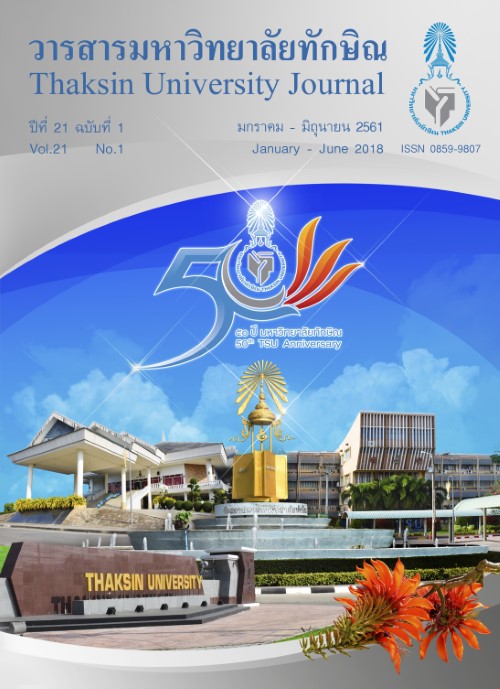Ecology of Aedes Mosquitoes in Kreang Sub-District, Cha-Uat District, Nakhon Si Thammarat
Main Article Content
Abstract
To study the Aedes mosquitoes’ ecology, identify the risk areas, study distribution model of Aedes mosquitoes and relationship between entomological indices and ecological factors. Samples were collected from 72 households using stratified sampling. All water containers were sampled for mosquito larvae; humidity, temperature and pH were measured. Scatter Plot were used to show the distribution of Aedes mosquitoes. Pearson correlation coefficients were used to explore the relationship. The t-Test and Kruskal Wallis Test were used to test the significant of the different of number of Aedes larvae in the different water containers. The results showed that Aedes mosquitoes were found in 15 types of water containers. All of 1,340 mosquito larvae, 659 were Aedes, 57 were Anopheles, 282 were Culex, and 342 were others. Plastic buckets were the most of breeding sites. Number of Aedes mosquito larvae were not different in different color, lid status and type of material used for the containers. Kreang Sub-District was indicated high risk of Dengue Haemorrhagic Fever transmission (BI > 50). Aedes mosquitoes were concentration distributed in the range of 50-70% humidity. Removal or avoidance of mosquito-bred breeding habitat behavior. It was a way to control the spread of mosquitoes. This will lead to a gradual decline in the spread of dengue haemorrhagic fever.
Article Details

This work is licensed under a Creative Commons Attribution-NonCommercial-NoDerivatives 4.0 International License.
References
National Institute of Health.
[2] Rakthong, S., Dejpia, S., Kongjan, A. and Kongjan, S. (2010). Local History Research Project, Krajood with Production Process of Kreang Villagers: From the Living to the Product Era. Nakhon Si Thammarat: Cha-Uat Kreangthamvittaya School.
[3] Sujariyakul, A. and Wonghiranrachata, W. (2003). “Surveillance of Vector-borne Disease in Pakphanang
Basin Project Vector-borne Disease Control Office No. 4, Songkhla”, Journal of Health Science. 12, 68-74.
[4] Promprao, S. (2011). Community Participation in the Study of Mosquito Diversity in the Khuan Kreang
Peat Land. Nakhon Si Thammarat: Nakhon Si Thammarat Rajabhat University, Research and Development Institute.
[5] Rattanarithikul, R. and Panthumsiri, P. (1994). “Illustrated Keys to the Medically Important Mosquitoes of
Thailand”, The Southeast Asian Journal of Tropical Medicine and Public Health. 25(Suppl 1), 1-66.
[6] Thavara, U., Bhakdeenuan, P., Tawatsin, A., Chompoosri, J., Khumsawads., Ch., Phusup, Y., Phumee, A.,
Pengsakul, Th., Siriyasatien, P. and Sangkitporn, S. (2015). “Biology of Dengue Vectors and Serotypes
of Dengue Virus in Infectious Cycle in Thailand”, Bulltin of the Department of Medical Sciences. 57(2), 186-195.
[7] Alto, B. W. and Juliano, S. A. (2001). “Precipitation and Temperature Effects on Populations of Aedes albopictus
(Diptera: Culicidae): Implications for Range Expansion”, Journal of Medical Entomology. 38(5), 646-656.
[8] Khantikul, N., Sudathip, P., Saejeng, A., Tipmontree, R. and Suwankerd, W. (2013). “Social and Environmental
Factors Affect Dengue Hemorrhagic Fever Epidemics in Upper Northern Thailand”, Lanna Public Health Journal. 9(1), 21-34.
[9] Thammapalo, S., Chongsuwiwatwong, V., McNell, D. and Geater, A. (2006). “The Climatic Factors Influencing
the Occurrence of Dengue Hemorrhagic Fever in Thailand”, The Southeast Asian Journal of Tropical Medicine and Public Health. 36(1), 191-196.
[10] Apiwathnasorn, Ch. (2012a). “Literature Review of Parasitoids of Filth Flies in Thailand: a List of Species
with Brief Notes on Bionomics of Common Species”, The Southeast Asian Journal of Tropical Medicine and Public Health. 43(1), 48-54.
[11] Karim, M.N., Munshi, S.U., Anwar, N. and Alam, M.S. (2012). “Climatic Factors Influencing Dengue Cases
in Dhaka City: a Model for Dengue Prediction”, Indian Journal of Medical Research. 136(1), 32-39.
[12] Platt, R. (1957). “Physiology and Pathology of The Kidney”, British Medical Bulletin. 13(1), 74.
[13] Reiter, P. (2001). “Climate Change and Mosquito-Borne Disease”, Environmental Health Perspect.
109 (Suppl 1), 141-161.
[14] Russell, R.C. (1998). “Mosquito-Borne Arboviruses in Australia: The Current Scene and Implications of
Climate Change for Human Health”, International Journal for Parasitology. 28(6), 955-969.
[15] Kaikaew, J., Promprao, S. and Sutin, S. (2012). The Larval Occurrence of Aedes aegypti and Ae. albopictus
in Khuan Khrang Peat Swamp Forest, Nakhon Si Thammarat, Thailand. In Proceedings: 1st ASEAN Plus
Three Graduate Research Congress, 258-263. March 1-2, 2012 at International Convention Center,
The Empress Hotel, Chiang Mai, Thailand: Chiang Mai University.
[16] Sayle, M. H. (1928). “The Metabolism of Insects”, Journal of the Quarterly Review of Biology. 3(4), 542-553.
[17] Hochachka, P. W. and Sommero, G. N. (1984). Biochemical Adaptation. New Jersey. Princeton.
[18] Getachew, D., Tekie, H., Gebre-Michael, T., Balkew, M. and Mesfin, A. (2015). Breeding Sites of Aedes aegypti:
Potential Dengue Vectors in Dire Dawa, East Ethiopia. Interdisciplinary Perspectives on Infectious
Diseases, 2015, Article ID: 706276. Retrieved January 12, 2017, from http://dx.doi.org/10.1155/2015/706276.
[19] Yee, D.A., Kneitel, J.M. and Juliano, S.A. (2010). “Environmental Correlates of Abundances of Mosquito
Species and Stages in Discarded Vivid Tires”, Journal of Medical Entomology. 47(1), 53-62.

